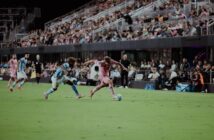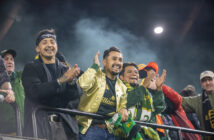
The Nottingham Forest side of 1979
Photo: Northern Echo
Nottingham Forest – When they were the best
by Stephen Brandt
Brian Clough was the best manager in England and the best manager England never had. His time at Derby showed that he could make winners out of any club.
However, his work at Nottingham Forest showed a stubborn genius who could make a small club world-beaters. For a short time, Nottingham Forest looked like the next great club in England, even as legendary Liverpool racked up titles and wins.
On January 6, 1975 Brian Clough took the job at Nottingham Forest as the club sat at 13th in the old Second Division.
Within five years, the club and Clough knocked the two-time European Cup winner Liverpool off their pedestal. With the addition of Peter Talyor as Clough’s assistant manager, Nottingham Forest picked up steam. At every stop Clough and Taylor worked together, the club had success. When Clough left for Leeds without Taylor, he only lasted forty-four days.
Behind the unprecedented success of Nottingham Forest and the Clough-Taylor leadership are the players. The backbone of the side included Archie Gemmill, Martin O’Neill, Peter Shilton, Ian Bowyer, John Robertson, Viv Anderson, Tony Woodcock, Larry Loyd, Trevor Francis, and Frank Clark. These players worked hard for Clough to get into the team. At first glance, some of the players weren’t considered talented enough to compete on the level Nottingham Forest, while others were notorious, like Scotsman Kenny Burns.
Burns had such a bad reputation that the chairman of Nottingham Forest told Clough not to waste money on a buy. Burns was a drinker, and was prone to commit fouls at the most inopportune times. Frank Clark who would go on to become a legend at the club, came in as a free transfer.
From 1977 through 1978, Nottingham Forest won the old First Division and League Cup Double. Flags dot Anfield today from European wins from 1977, 1978 and 1981, which all surround the years that Forest won in Europe.
What’s also behind this success is that through many of announcements of the players, Clough stayed true to the stubborn everyday man persona which brought him great success, focusing on finding excellent talent. One such example is Trevor Francis.
No one had bought a player for more that $550,000; Clough brought him in for one million dollars. True to form, Clough arrived at the Francis press conference sporting a track suit and carrying a squash racket for a match he scheduled right after.

The Brian Clough statue that stands proudly in Nottingham city centre was unveiled on 6 November 2008 by Brian’s widow Barbara in front of an estimated crowd of 4,000 people.The statue was paid for thanks to the efforts of the Brian Clough Statue Fund, a group of volunteers who raised nearly £70,000 by selling Cloughie-related merchandise.
To secure the money for the transfer of Francis from Birmingham City, Nottingham Forest had to win the 1978 First Division to secure the prize money to use for the Francis transfer. By acquiring the complementary talent of Francis, John Robertson and Martin O’Neill, Forest had a formative attack force. The FA prevented Francis from playing in Europe for three months coinciding with the finals. Francis had to sit out since he was transferred in February and missed the registration deadline.
Standing in the way of Nottingham Forest on their journey to the European Cup finals was Liverpool, the previous year’s cup winner. Nottingham Forest took Liverpool out 2-0, facing them next was AEK Athens.
AEK Athens weren’t at Forest’s level and lost by an aggregate score of 7-2. In the quarter finals, Nottingham Forest quickly dispatched the Grasshoppers of Zurich with a 5-2 win. The semi-finals were a steeper test for Nottingham Forest as they came up against a power in Koln. It took Nottingham Forest over two legs to beat them 4-3 to head to the finals against Malmö from Sweden.
Malmö had a slightly harder way through to the finals. First, they had to dispatch Monaco, and it took them an away goal to knock them off 1-0. Dynamo Kiev and Wis Krakow fell next, 2-0, and 5-3 respectively. In the semi-finals Malmö had to slug it out for a 1-0 win over Vienna.
Nottingham Forest had success on the wings with debutant Francis and John Robertson. The only goal of the match would come with the dying moments of the first half when Francis put a ball past the goalkeeper at 45+1 to take the lead. With their backs to wall, Malmö sprung the offside trap, annoying both British commentary teams and Clough. Malmö never overcame their underdog mindset, and Nottingham Forest never tried to hit for the second goal with any effort, seemingly content with a 1-0 score.
Nottingham Forest followed up this European Cup win with a second European Cup the next year against HSV. Shortly after the Cup wins, Clough and Taylor had a major falling out. The two never made up which haunted Clough even after Taylor died. Nottingham Forest soon became just another club in the first division.
Success followed Forest into the early 1990s, but they were relegated in 1993. After this defeat, Clough retired and left the keys to the club to Frank Clark, to return Forest to English Premier League the following season of 1993-1994.
![Prost International [PINT]](https://prostinternational.com/wp-content/uploads/2021/08/PINTtFontLogoRoboto1536x78.jpg)


